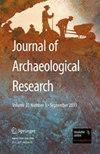The Rise of Pastoralism in the Ancient Near East
IF 4.1
1区 历史学
Q1 ANTHROPOLOGY
引用次数: 0
Abstract
In this paper, we present a history of pastoralism in the ancient Near East from the Neolithic through the Bronze Age. We describe the accretional development of pastoral technologies over eight millennia, including the productive breeding of domestic sheep, goats, and cattle in the early Neolithic and the subsequent domestication of animals used primarily for labor—donkeys, horses, and finally camels—as well as the first appearance of husbandry strategies such as penning, foddering, pasturing, young male culling, and dairy production. Despite frequent references in the literature to prehistoric pastoral nomads, pastoralism in Southwest Asia was strongly associated with sedentary communities that practiced intensive plant cultivation and was largely local in nature. There is very little evidence in prehistoric and early historic Southwest Asia to support the notion of a “dimorphic society” characterized by separate and specialized agriculturists and mobile pastoralists. Although mobile herders were present in the steppe regions of Syria by the early second millennium BC, mobile pastoralism was the exception rather than the rule at that time; its “identification” in the archaeological record frequently derives from the application of anachronistic ethnographic analogy. We conclude that pastoralism was a diverse, flexible, and dynamic adaptation in the ancient Near East and call for a reinvigorated and empirically based archaeology of pastoralism in Southwest Asia.古代近东畜牧业的兴起
在本文中,我们介绍了古代近东从新石器时代到青铜时代的放牧史。我们描述了八千年间畜牧技术的累积发展,包括新石器时代早期家养绵羊、山羊和牛的繁殖,以及随后主要用于劳动的动物--驴、马,最后是骆驼--的驯化,以及圈养、饲养、放牧、淘汰小公畜和乳制品生产等畜牧业策略的首次出现。尽管文献中经常提到史前畜牧游牧民族,但西南亚的畜牧业与从事密集型植物种植的定居社区密切相关,而且主要是地方性的。在史前和历史早期的西南亚,很少有证据支持 "二形社会 "的概念,即由不同的专门农耕者和流动牧民组成的社会。尽管在公元前第二个千年早期,叙利亚的草原地区已经出现了流动牧民,但流动牧业在当时只是例外而非普遍现象;考古记录中对流动牧业的 "认定 "往往来自于不合时宜的人种学类比。我们的结论是,畜牧业在古代近东是一种多样、灵活和动态的适应方式,并呼吁对西南亚的畜牧业重新进行以经验为基础的考古研究。
本文章由计算机程序翻译,如有差异,请以英文原文为准。
求助全文
约1分钟内获得全文
求助全文
来源期刊

Journal of Archaeological Research
Multiple-
CiteScore
10.20
自引率
7.90%
发文量
9
期刊介绍:
Journal of Archaeological Research publishes the most recent international research summaries on a broad range of topics and geographical areas. The articles are intended to present the current state-of-the-discipline in regard to a particular geographic area or specific research topic or theme. This authoritative review journal improves access to the growing body of information and literature through the publication of original critical articles, each in a 25-40 page format.2-Year Impact Factor: 4.056 (2017) 5-Year Impact Factor: 4.512 (2017)2 out of 85 on the Anthropology listIncluded in the European Reference Index for the Humanities (ERIH) PLUS The European Reference Index for the Humanities and the Social Sciences (ERIH PLUS) was created and developed by European researchers under the coordination of the Standing Committee for the Humanities (SCH) of the European Science Foundation (ESF). https://dbh.nsd.uib.no/publiseringskanaler/erihplus/about/indexSCImago Journal and Country Rank (SJR) 2018: 1.7102 out of 263 on the Archeology (Arts and Humanities) list3 out of 254 on the Archeology list2 out of 131 on the General Arts and Humanities listSJR is a measure of the journal’s relative impact in its field, based on its number of citations and number of articles per publication year.Source Normalised Impact per Paper (SNIP) 2018: 2.112The SNIP measures contextual citation impact by weighting citations based on the total number of citations in a subject field. The impact of a single citation is given higher value in subject areas where citations are less likely, and vice versa.CiteScore 2018: 3.86Rated ''A'' in the Australian Research Council Humanities and Creative Arts Journal List. For more information, visit: http://www.arc.gov.au/era/journal_list.htm
SCImago Journal and Country Rank (SJR) 2011 1.227 Archeology 1 out of 96 Archeology (Arts and Humanities) 1 out of 59 Arts and Humanities (miscellaneous) 1 out of 243
 求助内容:
求助内容: 应助结果提醒方式:
应助结果提醒方式:


